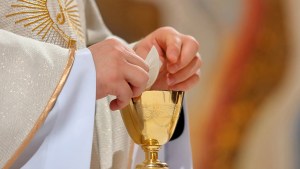Lenten Campaign 2025
This content is free of charge, as are all our articles.
Support us with a donation that is tax-deductible and enable us to continue to reach millions of readers.
One of the required features of reciting the Eucharistic Prayer at Mass in the Roman Rite is the naming of the pope and local bishop.
Why is that?
Sign of unity
The Catechism of the Catholic Church explains why the priest will always mention the name of the current pope and local bishop in the midst of the Eucharistic Prayer:
The whole Church is united with the offering and intercession of Christ. Since he has the ministry of Peter in the Church, the Pope is associated with every celebration of the Eucharist, wherein he is named as the sign and servant of the unity of the universal Church. the bishop of the place is always responsible for the Eucharist, even when a priest presides; the bishop’s name is mentioned to signify his presidency over the particular Church, in the midst of his presbyterium and with the assistance of deacons. the community intercedes also for all ministers who, for it and with it, offer the Eucharistic sacrifice:
CCC 1369
The bishop is the pope’s representative, so it makes sense that he would also be named, as he is the local guardian of unity.
In addition to naming the pope and bishop, the priest also performs an action of unity that is often unnoticed and has a rich history.
During Mass the priest breaks a small part of the consecrated host and drop it into the chalice of consecrated wine. It is a silent ritual, one that is easily missed as it happens so quickly.
According to Nikolaus Gihr in the book The Holy Sacrifice of the Mass, the action of placing a small particle of the host into the chalice has roots in the Early Church, and is a custom that was meant to signify unity with the pope and local bishop:
Participation in the same Holy Sacrifice was regarded as a sign and pledge of ecclesiastical Communion; mutually to prove and maintain this, Popes and bishops sent to other bishops, or priests too, parts of Consecrated Hosts, which the recipients dropped into the chalice and consumed …This custom existed in Rome until about the ninth century. There the Pope on Sundays and feast-days sent to those priests who had charge of Divine service at the churches within the city, the Eucharist as a symbol of communion with the ecclesiastical Head, and as a sign that they were empowered to celebrate.
Unity is one of the marks of the Church, and these small gestures help remind the priest that he is united to a much larger Body of Christ.



